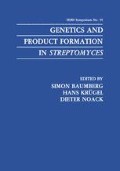Abstract
The current state of antibiotic research is characterized by contradictory movements, such as decreasing interest of industrial companies in R&D efforts on classical antibiotic screening and further derivatisation of known substances versus increasing interest in new applications and new means of production (e.g. hybrid antibiotics or biotransformations), or booming academical interest in basic research on genetics and regulation of antibiotic biosynthesis and resistance versus slow-down of so-called “defense-research” of companies marketing major antibiotic groups. In this context it is interesting to note that recent progress on our understanding of the mechanisms, evolution and distributing genetic forces of antibiotic resistance is enormous, as is manifested in several reviews and books (Davies and Smith, 1978; Foster, 1983; Piepersberg et al., 1988; Cundliffe, 1989; Wiedemann et al., 1986; Levy and Novick, 1986) and that, in contrast, our knowledge on the interplay between antibiotic action, resistance development and regulation of antibiotic production is very poor. Our current view on the scenery might change considerably, whenever we know more about the origin and function of antibiotics (also “secondary metabolites” or “natural products”) in nature (Zähner et al., 1982; Hütter, 1986; Williams et al., 1989; Davies, 1990; Piepersberg et al., 1988 and this volume).
Access this chapter
Tax calculation will be finalised at checkout
Purchases are for personal use only
Preview
Unable to display preview. Download preview PDF.
References
Benveniste, R., and Davies, J., 1973, Aminoglycoside antibiotic -inactivating enzymes in actinomycetes similar to those present in clinical isolates of antibiotic-resistant bacteria, Proc. Natl. Acad. Sci. USA, 70: 2276.
Brenner, S., 1988, The molecular evolution of genes and proteins: a tale of two serines, Nature, 334: 528.
Van Buul, C.P.J.J., and van Knippenberg, P.H.,1985, Nucleotide sequence of the ksgA gene of Escherichia coli: comparison of methyltransferases effecting dimethylation of adenosine in ribosomal RNA, Gene, 38: 65.
Cohen, G., Shiffman, D., Mevarech, M., and Aharonowitz, Y., 1990, Microbial isopenicillin N synthase genes: structure, function, diversity and evolution, Trends Biotechnol., 8: 105.
Cundliffe, E., 1989, How antibiotic-producing organisms avoid suicide, Ann. Rev. Microbiol., 43: 207.
Davies, J., 1990, What are antibiotics? Ancient functions for modern activities, Mol. Microbiol., submitted.
Davies,J., and Smith,D.I., 1978, Plasmid-determined resistance to antimicrobial agents, Ann. Rev. Microbiol., 32: 469.
Edelman,A.M., Blumenthal, D.K., and Krebs, E.G., 1987, Protein serine/threonine kinases, Ann. Rev. Biochem., 56: 567.
Foster,T.J., 1983, Plasmid-determined resistance to antimicrobial drugs and toxic metal ions in bacteria, Microbiol. Rev., 47: 361.
O’Hara,K., Kanda,T., Ohmiya,K., Ebisu, T., and Kono, M., 1989, Purification and characterization of macrolide 2’Ophosphotransferase from a strain of Escherichia coli that is highly resistant to erythromycin, Antimicrob. Agents Chemother., 33: 1354.
Witter, H., 1986, Overproduction of microbial metabolites, in: “Biotechnology”, Vol. 4., H.J. Rehm, and G. Reed, ed., VCH Verlagsges., Weinheim.
Levy,S.B., and Novick,R.P.,1986, “Antibiotic Resistance Genes: Ecology, Transfer, and Expression,” Cold Spring Harbor Laboratory, Cold Spring Harbor, New York.
Mansouri,K., Pissowotzki, K., Distler, J., Mayer, G., Heinzel, P., Braun, C., Ebert, A., and Piepersberg, W., 1989, Genetics of streptomycin production, in: “Genetics and Molecular Biology of Industrial Microorganisms,” C.L. Hershberger, S.W. Queener, and G. Hegeman,ed., American Society for Microbiology, Washington DC.
Miller,J.R., and Ingolia,T.D., 1989, Cloning beta-lactam genes from Streptomyces spp. and fungi, in: “Genetics and Molecular Biology of Industrial Microorganisms,” C.L. Hershberger, S.W. Queener, and G. Hegeman,ed., American Society for Microbiology, Washington DC.
Murray, I.A., Gil, J.A., Hopwood, D.A., and Shaw, W.V., 1989, Nucleotide sequence of the chloramphenicol acetyltransferase gene of Streptomyces acrimycini, Gene, 85: 283.
Pernodet,J.-L., Boccard, F., Alegre, M.-T., Blondelet-Rouault, M.-H., and Guerineau,M.,1988, Resistance to macrolides, lincosamides and streptogramin type antibiotics due to a mutation in an rRNA operon of Streptomyces ambofaciens, EMBO J., 7: 277.
Piepersberg, W., Distler, J., Heinzel, P., and Perez-Gonzalez, J.A., 1988, Antibiotic resistance by modification: Many resistance genes could be derived from cellular control genes in actinomycetes. - A hypothesis, Actinomycetol., 2: 83.
Walker,M.S., and Walker, J.B., 1970, Streptomycin biosynthesis and metabolism. Enzymatic phosphorylation of dihydro-
streptobiosamine moieties of dihydrostreptomycin(streptidino)phosphate and dihydrostreptomycin, J.Biol. Chem., 245: 6683.
Wiedemann, B., Bennett, P.M., Linton, A.H., Sköld, O., and Speller,D.C.E., 1986, “Evolution, Ecology and Epidemiology of antibiotic resistance,” Academic Press, London.
Williams,D.H., Stone,M.J., Hauk, P.R., and Rahman, S.K., 1989, Why are secondary metabolites (natural products) biosynthesized?, J. Nat. Prod., 52: 1189.
Zähner, H., Drautz, H., and Weber, W., 1982, Novel approaches to metabolite screening, in: “Bioactive microbial products: Search and discovery,” J.D. Bu’Lock, L.J. Nisbet, and D.J. Winstanley, ed., Academic Press, London.
Author information
Authors and Affiliations
Editor information
Editors and Affiliations
Rights and permissions
Copyright information
© 1991 Plenum Press, New York
About this chapter
Cite this chapter
Piepersberg, W. (1991). Antibiotic Resistance: Present State and Prospects. In: Baumberg, S., Krügel, H., Noack, D. (eds) Genetics and Product Formation in Streptomyces . Federation of European Microbiological Societies Symposium Series, vol 55. Springer, Boston, MA. https://doi.org/10.1007/978-1-4684-5922-7_18
Download citation
DOI: https://doi.org/10.1007/978-1-4684-5922-7_18
Publisher Name: Springer, Boston, MA
Print ISBN: 978-1-4684-5924-1
Online ISBN: 978-1-4684-5922-7
eBook Packages: Springer Book Archive

